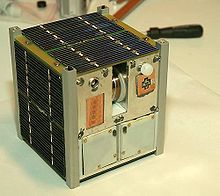
Back CubeSat Bulgarian CubeSat Catalan CubeSat Czech CubeSat German CubeSat Spanish Kuupsatelliit Estonian تاسواره Persian CubeSat Finnish CubeSat French CubeSat Galician

A CubeSat is a class of small satellite with a form factor of 10 cm (3.9 in) cubes.[1] CubeSats have a mass of no more than 2 kg (4.4 lb) per unit,[2] and often use commercial off-the-shelf (COTS) components for their electronics and structure. CubeSats are deployed into orbit from the International Space Station, or launched as secondary payloads on a launch vehicle.[3] As of December 2023[update], more than 2,300 CubeSats have been launched.[4]
In 1999, California Polytechnic State University (Cal Poly) professor Jordi Puig-Suari and Bob Twiggs, a professor at Stanford University Space Systems Development Laboratory, developed the CubeSat specifications to promote and develop the skills necessary for the design, manufacture, and testing of small satellites intended for low Earth orbit (LEO) that perform scientific research and explore new space technologies. Academia accounted for the majority of CubeSat launches until 2013, when more than half of launches were for non-academic purposes, and by 2014 most newly deployed CubeSats were for commercial or amateur projects.[3]

Functions typically involve experiments that can be miniaturized or serve purposes such as Earth observation or amateur radio. CubeSats are employed to demonstrate spacecraft technologies intended for small satellites or that present questionable feasibility and are unlikely to justify the cost of a larger satellite. Scientific experiments with unproven underlying theory may also find themselves aboard CubeSats because their low cost can justify higher risks. Biological research payloads have been flown on several missions, with more planned.[6] Several missions to the Moon and beyond are planning to use CubeSats.[7] The first CubeSats in deep space were flown in the MarCO mission, where two CubeSats were launched towards Mars in May 2018 alongside the successful InSight mission.[8]
Some CubeSats have become countries' first-ever satellites, launched either by universities, state-owned, or private companies. The searchable Nanosatellite and CubeSat Database lists over 4,000 CubeSats that have been or are planned to be launched since 1998.[4]
- ^ CubeSat Design Specification Rev. 13, The CubeSat Program, Cal Poly SLO
- ^ Cubesat Design Specification (PDF). San Luis Obispo: Cal Poly SLO. 2020. p. 12.
- ^ a b Cite error: The named reference
databasewas invoked but never defined (see the help page). - ^ a b Kulu, Erik (28 August 2020). "Nanosatellite & CubeSat Database". Retrieved 5 January 2024.
- ^ "Nanosatellites by launch years". nanosats.eu. Retrieved 2024-01-05.
- ^ Prachi Patel (2010-07-12). "Tiny Satellites for Big Science". Astrobiology Magazine. Archived from the original on 2020-11-20. Retrieved 2015-10-20.
- ^ "Tiny Cubesats Set to Explore Deep Space". Space.com. 11 May 2015. Retrieved 2015-10-20.
- ^ Stirone, Shannon (18 March 2019). "Space Is Very Big. Some of Its New Explorers Will Be Tiny. – The success of NASA's MarCO mission means that so-called cubesats likely will travel to distant reaches of our solar system". The New York Times. Retrieved 18 March 2019.